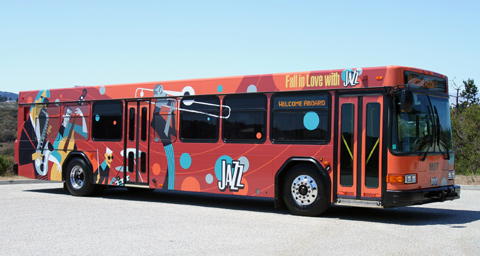Difference between revisions of "MST JAZZ"
(Created separate pages for each of the three JAZZ lines; utilized this page to instead describe the JAZZ service as a whole.) |
m |
||
| (3 intermediate revisions by 2 users not shown) | |||
| Line 1: | Line 1: | ||
[[File:MST-JAZZ-Bus-1.jpg|480px|right]] | [[File:MST-JAZZ-Bus-1.jpg|480px|right]] | ||
| − | JAZZ is [[Monterey-Salinas Transit]]'s | + | JAZZ is [[Monterey-Salinas Transit]]'s project to provide faster service along a 6.75-mile corridor through Monterey, Seaside, and Sand City. |
| − | In | + | In New Monterey and along Fremont, JAZZ operates as a basic [[bus rapid transit]] service in mixed traffic, with limited stop spacing, traffic signal priority, and at two intersections, queue jump lanes. Looped off of this main corridor are short segments of local service in residential Seaside. |
| − | JAZZ | + | Buses run about every 30 minutes on the main corridor and every 60 minutes for local service. |
| + | |||
| + | In a partnership with the Monterey Jazz Festival, JAZZ usually uses distinctive orange, jazz-themed, low-floor buses, and JAZZ stations are themed with "stage lighting." 30 displays distributed among the stations form a "linear jazz museum," with each display showcasing a year of the festival's history. A QR code at each display links to an online archive of music, video, and photos from the festival. | ||
| + | |||
| + | Other station amenities are minimal and varied: Larger stations may be mini-plazas "bulbed out" into parking lanes, with multiple shelters, bike racks, and trash cans; some smaller stations are nothing more than a curbside totem. All sheltered stations include seating, a display for real-time departure/arrival updates, and a pair of security cameras. Like all other MST lines, riders pay fare on board; there are no ticket machines at stations. | ||
{{#ask: [[Category:MST JAZZ routes]] | {{#ask: [[Category:MST JAZZ routes]] | ||
| − | | format=template| link=none| template=listlines2| ?rnum=| ?rlet=| ?to=| sort= | + | | format=template| link=none| template=listlines2| ?rnum=| ?rlet=| ?to=| sort=rlet|limit=500 |
}} | }} | ||
| − | {{bottom nav|MST}} | + | {{bottom nav|Monterey-Salinas Transit|alias=MST}} |
| − | [[Category: | + | [[Category:Monterey-Salinas Transit]] |
Latest revision as of 21:17, 29 June 2019
JAZZ is Monterey-Salinas Transit's project to provide faster service along a 6.75-mile corridor through Monterey, Seaside, and Sand City.
In New Monterey and along Fremont, JAZZ operates as a basic bus rapid transit service in mixed traffic, with limited stop spacing, traffic signal priority, and at two intersections, queue jump lanes. Looped off of this main corridor are short segments of local service in residential Seaside.
Buses run about every 30 minutes on the main corridor and every 60 minutes for local service.
In a partnership with the Monterey Jazz Festival, JAZZ usually uses distinctive orange, jazz-themed, low-floor buses, and JAZZ stations are themed with "stage lighting." 30 displays distributed among the stations form a "linear jazz museum," with each display showcasing a year of the festival's history. A QR code at each display links to an online archive of music, video, and photos from the festival.
Other station amenities are minimal and varied: Larger stations may be mini-plazas "bulbed out" into parking lanes, with multiple shelters, bike racks, and trash cans; some smaller stations are nothing more than a curbside totem. All sheltered stations include seating, a display for real-time departure/arrival updates, and a pair of security cameras. Like all other MST lines, riders pay fare on board; there are no ticket machines at stations.

